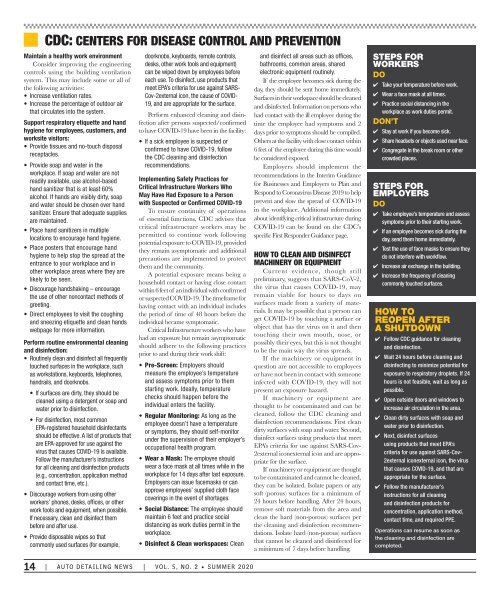Create successful ePaper yourself
Turn your PDF publications into a flip-book with our unique Google optimized e-Paper software.
CDC: CENTERS FOR DISEASE CONTROL AND PREVENTION<br />
Maintain a healthy work environment<br />
Consider improving the engineering<br />
controls using the building ventilation<br />
system. This may include some or all of<br />
the following activities:<br />
• Increase ventilation rates.<br />
• Increase the percentage of outdoor air<br />
that circulates into the system.<br />
Support respiratory etiquette and hand<br />
hygiene for employees, customers, and<br />
worksite visitors:<br />
• Provide tissues and no-touch disposal<br />
receptacles.<br />
• Provide soap and water in the<br />
workplace. If soap and water are not<br />
readily available, use alcohol-based<br />
hand sanitizer that is at least 60%<br />
alcohol. If hands are visibly dirty, soap<br />
and water should be chosen over hand<br />
sanitizer. Ensure that adequate supplies<br />
are maintained.<br />
• Place hand sanitizers in multiple<br />
locations to encourage hand hygiene.<br />
• Place posters that encourage hand<br />
hygiene to help stop the spread at the<br />
entrance to your workplace and in<br />
other workplace areas where they are<br />
likely to be seen.<br />
• Discourage handshaking – encourage<br />
the use of other noncontact methods of<br />
greeting.<br />
• Direct employees to visit the coughing<br />
and sneezing etiquette and clean hands<br />
webpage for more information.<br />
Perform routine environmental cleaning<br />
and disinfection:<br />
• Routinely clean and disinfect all frequently<br />
touched surfaces in the workplace, such<br />
as workstations, keyboards, telephones,<br />
handrails, and doorknobs.<br />
• If surfaces are dirty, they should be<br />
cleaned using a detergent or soap and<br />
water prior to disinfection.<br />
• For disinfection, most common<br />
EPA-registered household disinfectants<br />
should be effective. A list of products that<br />
are EPA-approved for use against the<br />
virus that causes COVID-19 is available.<br />
Follow the manufacturer’s instructions<br />
for all cleaning and disinfection products<br />
(e.g., concentration, application method<br />
and contact time, etc.).<br />
• Discourage workers from using other<br />
workers’ phones, desks, offices, or other<br />
work tools and equipment, when possible.<br />
If necessary, clean and disinfect them<br />
before and after use.<br />
• Provide disposable wipes so that<br />
commonly used surfaces (for example,<br />
doorknobs, keyboards, remote controls,<br />
desks, other work tools and equipment)<br />
can be wiped down by employees before<br />
each use. To disinfect, use products that<br />
meet EPA’s criteria for use against SARS-<br />
Cov-2external icon, the cause of COVID-<br />
19, and are appropriate for the surface.<br />
Perform enhanced cleaning and disinfection<br />
after persons suspected/confirmed<br />
to have COVID-19 have been in the facility:<br />
• If a sick employee is suspected or<br />
confirmed to have COVID-19, follow<br />
the CDC cleaning and disinfection<br />
recommendations.<br />
Implementing Safety Practices for<br />
Critical Infrastructure Workers Who<br />
May Have Had Exposure to a Person<br />
with Suspected or Confirmed COVID-19<br />
To ensure continuity of operations<br />
of essential functions, CDC advises that<br />
critical infrastructure workers may be<br />
permitted to continue work following<br />
potential exposure to COVID-19, provided<br />
they remain asymptomatic and additional<br />
precautions are implemented to protect<br />
them and the community.<br />
A potential exposure means being a<br />
household contact or having close contact<br />
within 6 feet of an individual with confirmed<br />
or suspected COVID-19. The timeframe for<br />
having contact with an individual includes<br />
the period of time of 48 hours before the<br />
individual became symptomatic.<br />
Critical Infrastructure workers who have<br />
had an exposure but remain asymptomatic<br />
should adhere to the following practices<br />
prior to and during their work shift:<br />
• Pre-Screen: Employers should<br />
measure the employee’s temperature<br />
and assess symptoms prior to them<br />
starting work. Ideally, temperature<br />
checks should happen before the<br />
individual enters the facility.<br />
• Regular Monitoring: As long as the<br />
employee doesn’t have a temperature<br />
or symptoms, they should self-monitor<br />
under the supervision of their employer’s<br />
occupational health program.<br />
• Wear a Mask: The employee should<br />
wear a face mask at all times while in the<br />
workplace for 14 days after last exposure.<br />
Employers can issue facemasks or can<br />
approve employees’ supplied cloth face<br />
coverings in the event of shortages.<br />
• Social Distance: The employee should<br />
maintain 6 feet and practice social<br />
distancing as work duties permit in the<br />
workplace.<br />
• Disinfect & Clean workspaces: Clean<br />
and disinfect all areas such as offices,<br />
bathrooms, common areas, shared<br />
electronic equipment routinely.<br />
If the employee becomes sick during the<br />
day, they should be sent home immediately.<br />
Surfaces in their workspace should be cleaned<br />
and disinfected. Information on persons who<br />
had contact with the ill employee during the<br />
time the employee had symptoms and 2<br />
days prior to symptoms should be compiled.<br />
Others at the facility with close contact within<br />
6 feet of the employee during this time would<br />
be considered exposed.<br />
Employers should implement the<br />
recommendations in the Interim Guidance<br />
for Businesses and Employers to Plan and<br />
Respond to Coronavirus Disease 2019 to help<br />
prevent and slow the spread of COVID-19<br />
in the workplace. Additional information<br />
about identifying critical infrastructure during<br />
COVID-19 can be found on the CDC’s<br />
specific First Responder Guidance page.<br />
HOW TO CLEAN AND DISINFECT<br />
MACHINERY OR EQUIPMENT<br />
Current evidence, though still<br />
preliminary, suggests that SARS-CoV-2,<br />
the virus that causes COVID-19, may<br />
remain viable for hours to days on<br />
surfaces made from a variety of materials.<br />
It may be possible that a person can<br />
get COVID-19 by touching a surface or<br />
object that has the virus on it and then<br />
touching their own mouth, nose, or<br />
possibly their eyes, but this is not thought<br />
to be the main way the virus spreads.<br />
If the machinery or equipment in<br />
question are not accessible to employees<br />
or have not been in contact with someone<br />
infected with COVID-19, they will not<br />
present an exposure hazard.<br />
If machinery or equipment are<br />
thought to be contaminated and can be<br />
cleaned, follow the CDC cleaning and<br />
disinfection recommendations. First clean<br />
dirty surfaces with soap and water. Second,<br />
disinfect surfaces using products that meet<br />
EPA’s criteria for use against SARS-Cov-<br />
2external iconexternal icon and are appropriate<br />
for the surface.<br />
If machinery or equipment are thought<br />
to be contaminated and cannot be cleaned,<br />
they can be isolated. Isolate papers or any<br />
soft (porous) surfaces for a minimum of<br />
24 hours before handling. After 24 hours,<br />
remove soft materials from the area and<br />
clean the hard (non-porous) surfaces per<br />
the cleaning and disinfection recommendations.<br />
Isolate hard (non-porous) surfaces<br />
that cannot be cleaned and disinfected for<br />
a minimum of 7 days before handling.<br />
STEPS FOR<br />
WORKERS<br />
DO<br />
✔ Take your temperature before work.<br />
✔ Wear a face mask at all times.<br />
✔ Practice social distancing in the<br />
workplace as work duties permit.<br />
DON’T<br />
✔ Stay at work if you become sick.<br />
✔ Share headsets or objects used near face.<br />
✔ Congregate in the break room or other<br />
crowded places.<br />
STEPS FOR<br />
EMPLOYERS<br />
DO<br />
✔ Take employee’s temperature and assess<br />
symptoms prior to their starting work.<br />
✔ If an employee becomes sick during the<br />
day, send them home immediately.<br />
✔ Test the use of face masks to ensure they<br />
do not interfere with workflow.<br />
✔ Increase air exchange in the building.<br />
✔ Increase the frequency of cleaning<br />
commonly touched surfaces.<br />
HOW TO<br />
REOPEN AFTER<br />
A SHUTDOWN<br />
✔ Follow CDC guidance for cleaning<br />
and disinfection.<br />
✔ Wait 24 hours before cleaning and<br />
disinfecting to minimize potential for<br />
exposure to respiratory droplets. If 24<br />
hours is not feasible, wait as long as<br />
possible.<br />
✔ Open outside doors and windows to<br />
increase air circulation in the area.<br />
✔ Clean dirty surfaces with soap and<br />
water prior to disinfection.<br />
✔ Next, disinfect surfaces<br />
using products that meet EPA’s<br />
criteria for use against SARS-Cov-<br />
2external iconexternal icon, the virus<br />
that causes COVID-19, and that are<br />
appropriate for the surface.<br />
✔ Follow the manufacturer’s<br />
instructions for all cleaning<br />
and disinfection products for<br />
concentration, application method,<br />
contact time, and required PPE.<br />
Operations can resume as soon as<br />
the cleaning and disinfection are<br />
completed.<br />
14 | AUTO DETAILING NEWS | VOL. 5, NO. 2 • SUMMER 2020

















